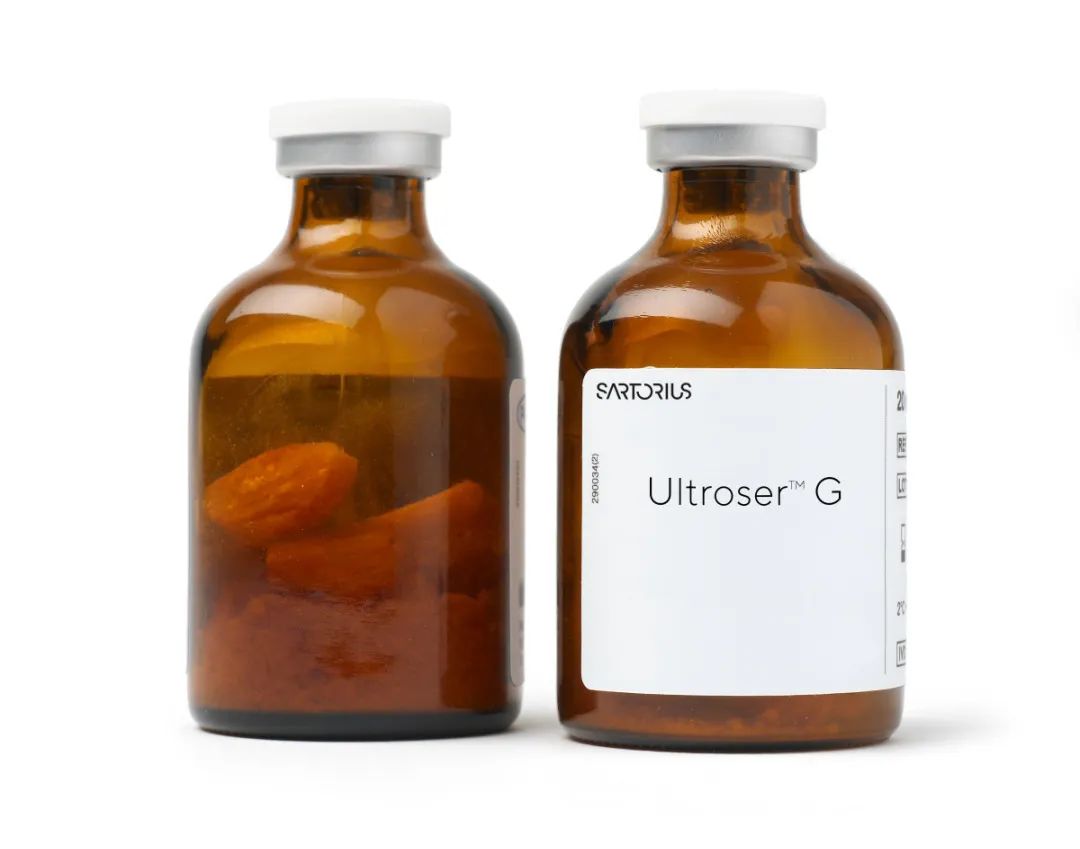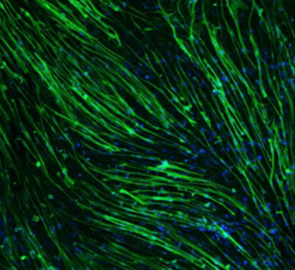【Sartorius】Ultroser™ G 血清替代品说明
中文说明
1.简介
Ultroser G 是一种血清替代品,用于替代动物细胞培养基中的胎牛血清(FBS)。
Ultroser G 血清替代品已成功应用于许多贴壁细胞的体外培养。也可用于产前诊断中对羊水细胞进行培养,从而进行染色体核型研究。Ultroser G 的生物活性是FBS 的 5 倍。该产品以冻干粉形式提供,相当于 20mL 的替代品。

2. 准备和溶解
将冻干粉溶解在 20mL 无热源的无菌蒸馏水(注射用水)中,具体操作如下:
(1)打破胶囊的顶端,打开小瓶;
(2)加入适当体积的注射用水:
- 首次打开瓶塞后,使用无菌且无热源的吸头进行添加,
- 或者使用无菌且无热源的注射器穿过瓶塞进行添加
两种方式均需在无菌环境下操作
(3)让冻干粉溶解 10-15 分钟。轻轻摇动试剂瓶或使用移液器/注射器连续吹吸以加速粉末溶解。
溶解后的溶液应为透明的粉红色。为保证安全,溶液应使用 0.2μm 孔径的无菌滤膜过滤后使用。这一过程不会导致活性损失。
3.浓缩
粉末溶解之后,Ultroser G 血清替代品的生物活性是 FBS 的 5 倍。使用浓度应为0.5%-4%(对应 FBS 浓度为 2.5%-20%),通常使用 2%的浓度(对应 FBS 浓度为10%)。将 2%的 Ultroser G 血清替代品和 98%的基础培养基混合,以制备标准浓度为 2%的溶液。对于不同种类的细胞,应对 0.5%-4%的使用浓度分别评估以确定细胞生长的最佳条件。对细胞生长的影响并不总与 Ultroser G 血清替代品的浓度成正比,同时与在相同条件下使用 FBS 得到的结果也无关联。
4. 培养基
通常用于培养的是含 FBS 的培养基(如 MEM 等)。然而,建议使用如 HAM 的 F12,DMEM,IMDM 或 RPMI 等富集培养基。
5. 培养效果
培养效果与使用 FBS 的效果相同。Ultroser G 血清替代品含有吸附因子。因此,可以用于在添加细胞前对塑料培养皿中的培养基进行预培养。然而,对于一些难以生长的细胞类型,或许需要在塑料培养皿中涂抹如下产品中的一种:多聚赖氨酸、胶原蛋白、细胞外基质或纤维连接蛋白等粘附因子,以提高细胞的粘附力。
6. 胰蛋白酶酶解
组织和单层细胞的胰蛋白酶酶解技术与使用 FBS 完全相同。然而,酶解时间应尽可能缩短以降低对细胞的损伤。为了去除残余的胰蛋白酶,在分散细胞前可能需要添加浓度为 0.5-1mg/mL 的胰蛋白酶抑制剂,如大豆提取物或抑肽酶。如细胞仍聚集在一起,可使用 40 μm 的细胞筛过滤细胞悬液。
7. 细胞转移
可采用两种技术从含有 FBS 的培养基中转移细胞进行亚培养。
■ 将细胞直接转移至含有 Ultroser G 血清替代品的培养基中
■ 或经过适应期后,在几次传代中逐渐减少血清的添加量:
- 第一次传代:50%含血清(MSS)的培养基+50%含最适浓度 Ultroser G 血清替代品的培养基
- 第二次传代:25% MSS+75%MSU
- 第三次传代:10% MSS+90%MSU
- 第四次传代:100%MSU
第二种技术可以使细胞更适应新的培养基。
在接种细胞前,测定培养基的最终 pH 值,如必要,将其调整至 7.2±0.1。可加入碳酸氢钠或合成缓冲液(HEPES)以提高介质的缓冲能力。
8. 储存
Ultroser G 血清替代品以冻干粉形式提供。该产品在室温下运输且必须在 2-8℃下保存。一经复溶,溶液应尽快使用。或将溶液分装于-20℃冻存,可保存数周。应避免反复冻融。
9. 参考资料
Le clonage des cellules du liquide amniotique, aide dans l'interprétation des mosaïques chromosomiques en diagnostic prénatal. Boué, J., et al., Ann. Genet., 1979, 22 No. 1, 3.
10. 制造商
Pall BioSepra, a Division of Pall France SAS, 48 avenue des Genottes, 95800 Cergy-Saint Christophe, 法国.
电话:+33 (0)1 34 20 78 00.
11.标签使用符号

12. 订购信息
产品 | 包装规格 | 货号 |
Ultroser G | 20 mL | 15950-017 |
Ultroser™ G
Serum Substitute for Animal Cell Culture
1. Introduction
Ultroser G is a semi-defined serum substitute that can be used as a replacement for FBS (Fetal Bovine Serum) in animal cell cultures.
It is designed for in vitro culture of anchorage- dependent cells. The biological activity is 5 times that of FBS. The product is supplied as a lyophilized powder corresponding to 20 mL of substitute.
Ultroser G is for research use only and not for use in diagnostic procedures.
2. Preparation and Solubilization
The lyophilized powder is solubilized in 20 mL sterile distilled pyrogen-free water (water for injection) as follows:
1. Open the vial by breaking the tip of thecapsule,
2. Introduce the appropriate volume of water using:
-A sterile pyrogen-free pipette after first having removed the stopper,
-Or a sterile pyrogen-free syringe by injection through the stopper.
These two operations must be performed under sterile conditions.
3. Allow the lyophilisate to swell for 10 to 15 minutes. Solubilization is rapidly obtained by gently shaking the flask or by successive aspirations using a pipette or syringe.
The reconstituted solution should be clear and pink-coloured. For greater safety, the solution may be filtered through a sterilizing membrane of 0.2 μm pore diameter. This will not result in any loss of activity.
3. Concentration
After reconstitution, Ultroser G serum substitute has a biological activity 5 times greater than that of FBS. It should be used at concentrations between 0.5% and 4% (2.5% to 20% of FBS). A concentration of 2% (10% of FBS) is generally used. To obtain a standardconcentration of 2%, mix 2% Ultroser G serumsubstitute with 98% base culture medium.For each cell type, various concentrationsfrom 0.5% to 4% will have to be evaluated to determine the optimal growth conditions.The effects on cell growth are not always proportional to the concentration of Ultroser G serum substitute, nor in correlation with the results obtained with FBS in the same conditions of use.
4. Culture Medium
The culture medium may be the one generally used for culture with FBS (MEM, etc.). However, the use of an enriched medium such as HAM’s F12, DMEM, IMDM, or RPMI is recommended.
5. Culture Support
The culture support is the same as that used with FBS. Ultroser G serum substitute contains adhesion factors. Therefore, it can be used for pre-incubation of the plastic dishes in the medium prior to adding the cells. However, for particular cell types which are difficult to grow, it may be necessary, to improve adhesion and differentiation, to coat the plastic dishes with one of the following products: poly-D-lysine, collagen, an extracellular matrix, or adhesion factors such as fibronectin.
6. Trypsinization
The trypsinization techniques for tissues and mono layered cells are the same as those used with FBS. However, the trypsinization period should be as short as possible, to minimize cell damage. To remove any residual trypsin, it may be necessary to add a trypsin inhibitor such as soya bean extract or aprotinin, at a concentration of 0.5 to 1 mg/mL, before dispersing the cells. If the cells still remain aggregated to each other, the cell suspension may be passed through a 40 μm cell sieve.
7. Cell Transfer
Two techniques may be employed for sub-culture from a medium containing FBS:
■Direct transfer of the cells in the medium supplemented with Ultroser G serum substitute,
■Or after an adaptation period by progressively reducing the quantity of serum, in several passages:
– 1st passage: 50% medium supplemented with serum (MSS) + 50% medium supplemented with Ultroser G serum substitute (MSU) in the optimum concentration
– 2nd passage: 25% MSS + 75% MSU
– 3rd passage: 10% MSS + 90% MSU
– 4th passage: 100% MSU
This second technique allows better adaptation of the cells to the new culture medium. Before seeding the cells, check the pH of the final medium and, if necessary, adjust to 7.2 ± 0.1. Sodium bicarbonate or a synthetic buffer (HEPES) may be added to improve the buffering power of the medium.
8. Storage
Ultroser G serum substitute is available as a lyophilized powder. The product is shipped at ambient temperature and must then be stored between 2 and 8 °C. Once reconstituted, the solution must be used up quickly. Other wise it can be aliquoted and stored frozen at -20 °C for several weeks. Frequent freezing and thawing must be avoided.
9. Manufacturer
Sartorius Stedim Chromatography Resins SAS 48 avenue des Genottes
95800 Cergy Saint Christophe
France
Phone +33 1 34 20 78 00
Emergency phone (Global) +44 1865 407 333
(Sartorius 29003)
10. Symbols Used on the Label

11.Ordering Information
Product | Pack Size | Part Number |
Ultroser G | 20 mL | 15950-017 |
其他细胞品类
别划走,精彩继续

长按识别
添加一对一专属技术支持

扫码进群
咨询详细产品信息

点在看,传递你的品味







